| Summary: Discover how integrating consequence modelling into fire and explosion risk assessment can enhance safety by identifying hazards, assessing likelihood and estimating potential consequences, supporting proactive risk mitigation strategies, and continuous improvement. |
Fire and explosion risks are a major concern for industrial facilities. They can cause significant damage to property, equipment and fatal injuries to people. In addition, they can result in costly downtime and lost production. The best way to prevent fires and explosions is to identify the hazards that could lead to them and take steps to reduce or eliminate them.
Physical effects due to fire and explosions in the oil & gas industry include,
- Smoke dispersion
- Tank Fires, Flash Fires, Jet Fires and Pool Fires
- Explosions and BLEVEs (Boiling Liquid Expanding Vapour Explosions)
Consequence modelling is an important part of risk assessment in QRA that aims to understand the above-mentioned types of physical effects that may occur as a result of loss of containment (LOC) from a process system and the ignition of that release. It allows you to estimate the potential impact of a fire or explosion on people and property. Such information can be used in the design of both active and passive fire-fighting systems. In addition, consequence modelling coupled with frequency analysis produces risk results which help to determine whether a particular hazard is acceptable or not.
Read: Fire and Explosion Risk Assessment (FERA)
Consequence Modelling – Methodology
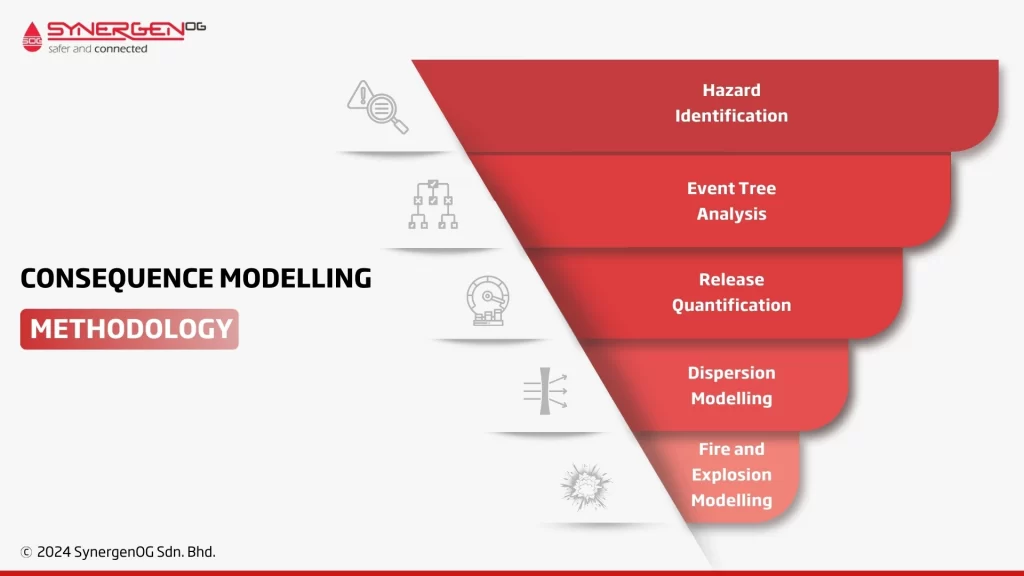
1. Hazard Identification
Consequence modelling begins with hazard identification, which is the process of recognizing and identifying potential hazards that could lead to accidents or undesired events. This step involves thoroughly examining the facility, its operations, and the materials or energy involved.
2. Event Tree Analysis
Once hazards are identified, event trees are developed. Event trees serve as graphical representations that show the different paths an accident can take, from the initial event to the final consequences. By understanding the cause-effect relationships and estimating the probabilities of different outcomes, event trees help in assessing the potential risks and consequences. An event tree is important because not all consequences occur at the same time.
For different LOC scenarios, certain consequences are more likely than others. An event tree shows the interactions between the various consequences
3. Release Quantification
This step involves quantifying the amount of material that could be released during a LOC event along with the release rate and duration. This is important information, as it affects both dispersion and fire/ explosion modelling.
4. Dispersion Modelling
Dispersion models are used to predict how released gaseous or two-phase materials (or smoke components) disperse in the environment. These models take into account factors like wind speed, atmospheric stability class, ambient temperature, and geographical layout to estimate how the hazardous materials will move and spread. LOC dispersion results are used to predict the severity of dispersion sensitive consequences such as flash fires and explosions.
5. Fire and Explosion Modelling
Finally, fire and explosion models are used to predict fire sizes, the distance to heat flux levels from the origin of the fires and the reach of explosion overpressure levels from the origin of explosions. Results are available for the different types or fire and explosion events predicted by the event trees. Most of these fire and explosion models are empirical models which have been validated by experimental values.
Commonly used modelling techniques (FDS, FLACS, PHAST)
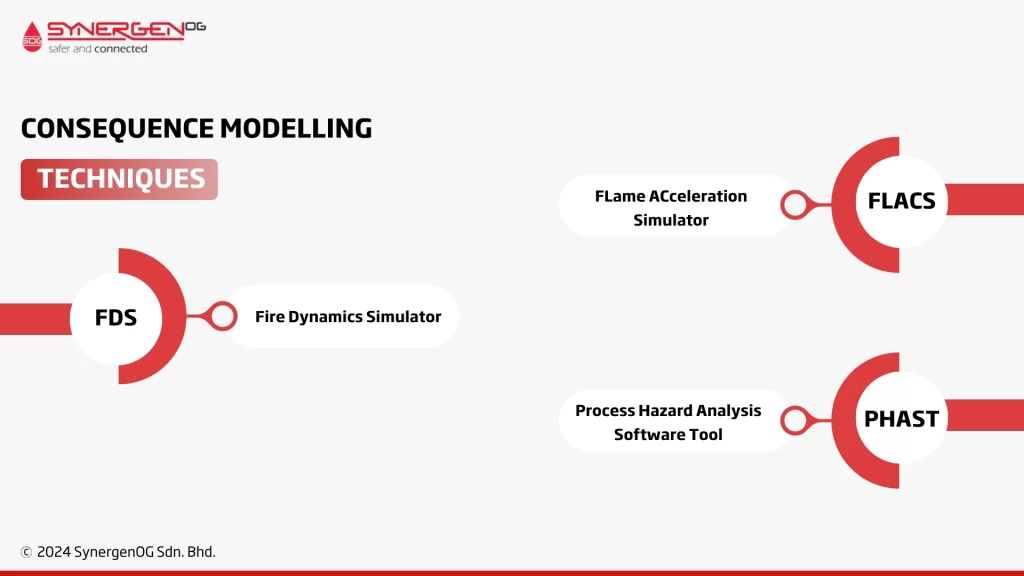
There are many modelling techniques used in consequence modelling. Each technique has its own strengths.
FDS (Fire Dynamics Simulator): FDS is a CFD (computational fluid dynamics) tool widely used for simulating fire behaviour. It helps predict the growth and spread of fires, including factors such as flame height, temperature, and smoke production.
FLACS (FLame ACceleration Simulator): FLACS is another commonly used CFD modelling tool that specialises in predicting gas explosions, vapour clouds, and other dispersion-related phenomena. It simulates the propagation of fire and explosion in complex environments.
PHAST (Process Hazard Analysis Software Tool): PHAST is a globally adopted solution for modelling discharge, dispersion, fires, explosions, and toxic effects. It uses free-field empirical and Computational Fluid Dynamics (CFD) methods
Learn About SynergenOG Process Safety Software Solutions
Importance of Incorporating Consequence Modelling in Risk Assessment
Consequence modelling is a vital part of the Fire and Explosion Risk Assessment (FERA). Consequence modelling enables you to predict which equipment and structures could potentially fail and predict injuries and fatalities to personnel, based on published survivability criteria. Moreover, consequence modelling provides a visual representation of the potential outcomes, making it easier to communicate credible hazards to stakeholders. It facilitates engagement and collaboration among various stakeholders by promoting transparency and understanding of the potential consequences.
A FERA is a combination of consequence modelling and frequency analysis. A FERA is a subset of a Quantitative Risk Assessment (QRA) where all other accident scenarios for example toxic gas releases, occupational accidents, transportation accidents are combined with fire and explosion accidents to give a final fatality risk number which is then compared to acceptable risk criteria.
Also Read: Quantifying and Assessing Risks – Quantitative Risk Assessment (QRA)
Benefits and Limitations of Incorporating Consequence Modelling in Risk Assessment
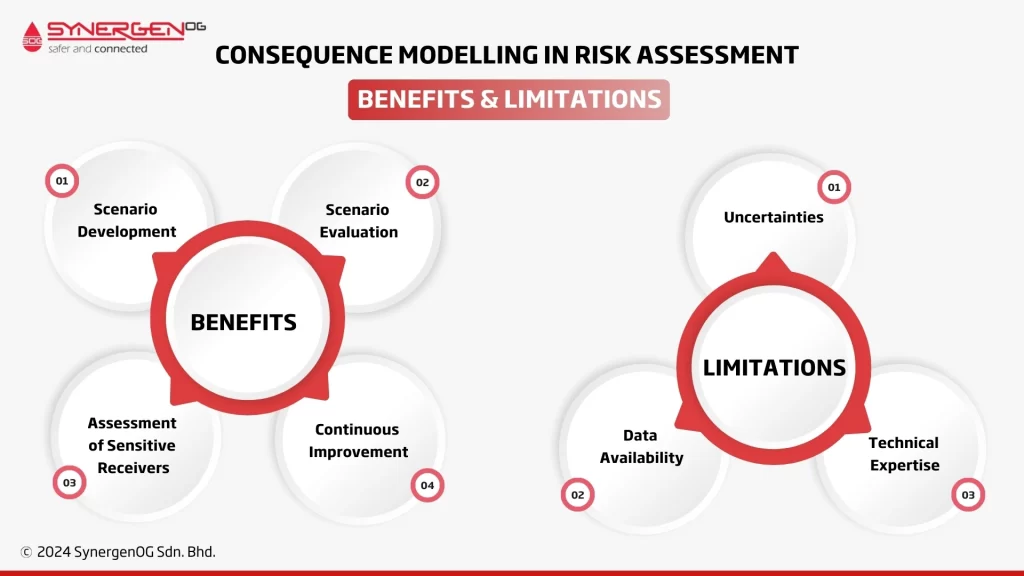
Benefits
-
- Scenario development: Consequence modelling can accommodate the development of any number of credible scenarios depending on the level of detail required. It can also accommodate sensitivity cases, comparing consequences from two different design options such as different locations of isolation valves.
- Scenario Evaluation: Using an event tree, consequence modelling can predict the difference in results with and without the effective function of various safety systems, for example, the different fire sizes and durations with and without isolation, blowdown or fire and gas detection.
- Assessment of Sensitive Receivers: Consequence modelling results are often used as inputs into studies such as Escape Evacuation and Rescue Analysis (EERA) and Emergency Systems Survivability Analysis (ESSA) to assess the survivability of critical safety equipment and systems.
- Continuous Improvement: Modelling softwares are continually being refined by comparing predicted consequences against the actual experimental results.
Limitations
- Uncertainties: Consequence modelling involves numerous assumptions and simplifications, which introduce uncertainties. These uncertainties can affect the accuracy of the predictions and, consequently, the risk assessment process.
- Data Availability: Consequence modelling relies on accurate and reliable data inputs. However, obtaining relevant data, especially for complex and unique scenarios, can often be challenging. Insufficient or inaccurate data can impact the reliability and validity of the modelling results.
- Technical Expertise: Conducting consequence modelling requires specialised technical expertise and resources. The complexity of the models and the interpretation and analysis of results necessitate skilled professionals and appropriate tools.
Conclusion
In conclusion, the integration of consequence modelling into fire and explosion risk assessment brings significant benefits, allows organisations to make informed decisions, develop targeted risk mitigation strategies, comply with regulations and standards, provide effective training, conduct regular inspections, utilise suitable safety equipment, and continuously improve safety protocols. This comprehensive approach supports the overall goal of ensuring the safety of personnel and protecting assets from the potential consequences of fire and explosion incidents.
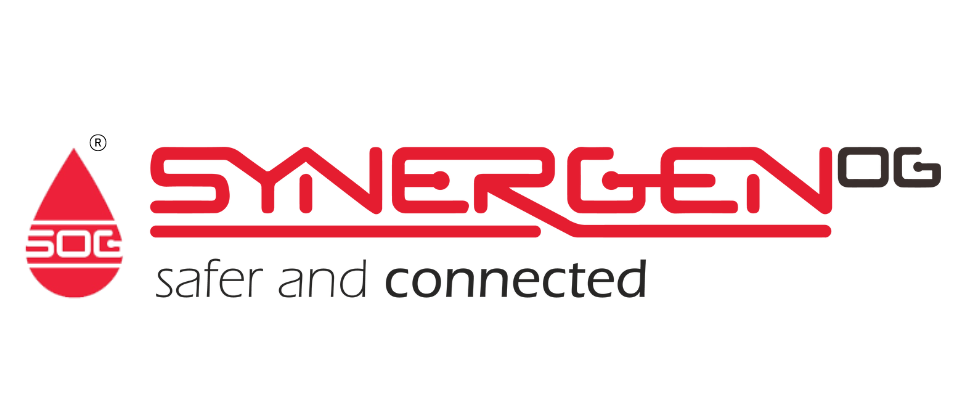
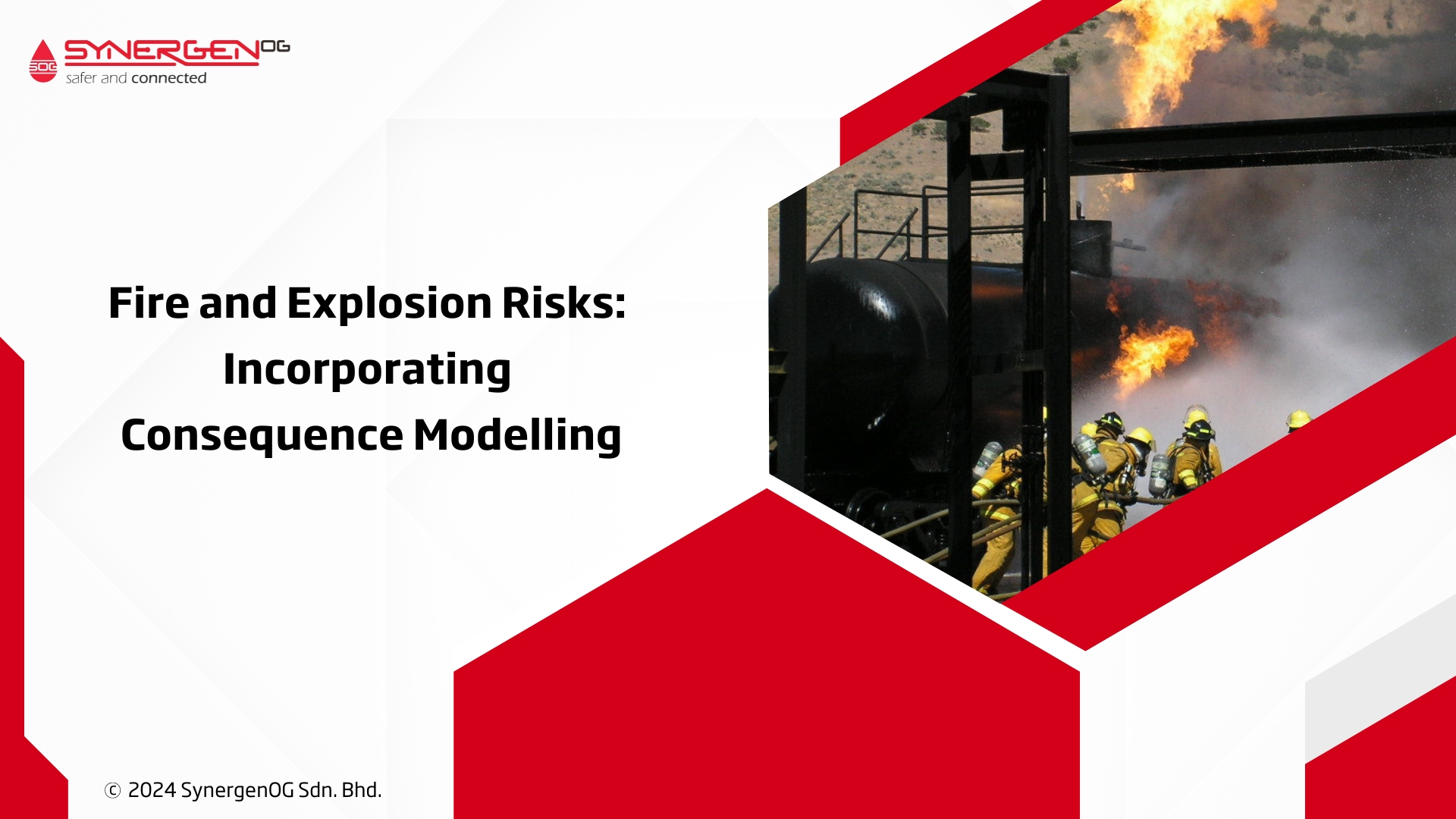
[…] of identifying potential hazards associated with the process and evaluating their likelihood and potential consequences. The evaluation results are then used to implement effective control measures to mitigate risks. By […]
[…] A process safety audit is a meticulous examination aimed at ensuring an organization’s safety management systems effectively mitigate risks. These audits assess whether operations meet relevant safety standards and identify areas for improvement. For high-stakes environments like refineries, these evaluations are crucial in preventing incidents that could have catastrophic consequences. […]
[…] identified pathway is analyzed to determine potential causes, consequences, and safeguards. This involves a discussion of the feasibility of the withdrawal, its potential […]
[…] Risk evaluation involves determining whether identified risks are acceptable based on established criteria and whether additional measures are required to reduce them. It is the decision-making stage of the broader risk assessment process, focusing on comparing estimated risk levels to predefined thresholds. […]
[…] to the simulation and prediction of potential outcomes resulting from hazardous events such as fires, explosions, and toxic releases. It involves the use of computational tools and analytical methods to estimate […]
[…] modelling is used to simulate the potential physical effects of hazardous events, such as gas dispersion, fireballs, jet fires, or explosions. These simulations provide vital information on the extent of damage that could occur under various […]